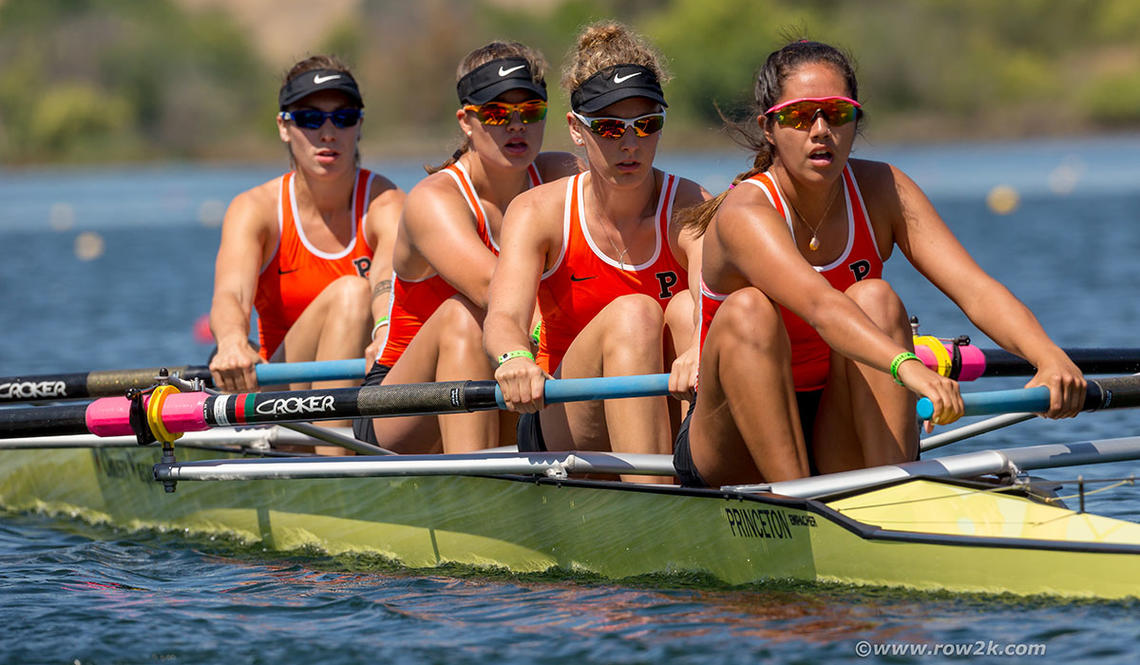
Walk-On Wonder
A Princeton rower remembers the workout that tested her limits — and revealed her potential
Rowing was completely new to Kanoe Shizuru ’17 when she picked up the sport as a Princeton freshman. In this PAW audio feature by Emily Erdos ’19, Shizuru revisits the demanding winter workout that helped to propel her to a spot on the Tigers’ NCAA Championships roster last spring.
TRANSCRIPT
Emily Erdos ’19: There’s something really scary about trying something new. And there’s something even scarier about trying something that you know absolutely nothing about. One Princeton student was brave enough to take that plunge. Meet Kanoe. Kanoe is actually her middle name, but it’s understandable that she goes by that.
Kanoe Shizuru ’17: My name is Jantien Kanoelani Shizuru.
EE: Most people don’t get that one on the first try.
KS: I am from Kailua, Hawai’i.
EE: Kanoe is one of three native Hawaiians in the Princeton Class of 2017. She’s a senior this year. She’s an impressive first-generation Ivy-Leaguer, and by June, she’ll have a degree in civil and environmental engineering and a certificate in sustainable energy. She’s also in the Women’s Society of Engineers, a sister of Kappa Alpha Theta, and a member of the Cannon Dial Elm Club. But none of these were the new thing that Kanoe dove head-first into at Princeton.
KS: I had vaguely heard of rowing, not really. Definitely had never done it, and was conveniently walking through the activities fair when I a bunch of tall people came up to me and asked me if I was playing a sport. To which I said no. And then, they asked me to join their sport. So I figured I would give it a try.
EE: Vaguely heard of rowing as in?
KS: It does not exist at all in Hawai’i. Both my parents paddled outrigger canoes, which is like the primary water sport in Hawai’i, but totally different stroke and everything from rowing. So I joined the women’s lightweight rowing team. It was definitely fun at first. I was kind of just, like, so overwhelmed by everything that was going on, and everything was so new, and I had never been in a boat before. I had never really erged before, so everything was just kind of new and exciting.
EE: And then, in the spring, things change for Kanoe. A little background on lightweight women’s rowing. As the name implies, there’s s weight limit. Every rower must be 130 pounds or under before each race. Kanoe is now a muscular 5’10”, and she’s struggling to make weight. The scale becomes her enemy.
KS: Despite coming into college pretty close to that, I instantly picked up lots of muscle when I started rowing. So I was working in the opposite direction from that goal. So that wasn’t very helpful. The winter was definitely a struggle, trying to figure out this sport, and trying to stay close to this weight limit.
EE: Kanoe is essentially starving herself to reach this goal.
KS: Yeah. I’m restricting all my calories during the day, eating, like, one source of sugary food right before practice, just to get me through the practice. I think I lost eight pounds in one week. (laughs) That was the highlight of that.
EE: She’s still about 10 pounds away, with only one week until the first race. But before she can lose any more weight, it all ends. The coach tells Kanoe that she’s just too big. Being a lightweight isn’t healthy for her.
KS: Yeah, I was really devastated, actually. I think I started crying that day, just because I felt like I was traying so hard and I was working so hard. And the crew aspect of it was going fine, but the weight-cutting just wasn’t. But I really wanted to be there; at this point, I had really — I was enjoying myself and I wanted to race, and I wanted to know what that felt like. Just being told that I literally wasn’t allowed to be on this team anymore, like, hurt a lot.
EE: But Kanoe isn’t ready to give up just yet.
KS: I’m very stubborn, and I think I was just so caught up in trying to get to this goal, that I was like, I can’t give up. I have to do it. I can’t stop now. I don’t think I’m a quitter. (laughs)
EE: And luckily for Kanoe, she still has one more option.
KS: The silver lining was that my coach told me that he thought there was a lot of potential and he didn’t want to see me stop rowing, and so, he gave me the option to join the women’s open-weight team.
EE: The open-weight women’s rowing team boasted quite a lot of perks.
KS: The first night after my coach told me that I couldn’t be on the lightweight team anymore, I went back to the dining hall, and conveniently, we were having this gourmet Agricola dinner, featuring short ribs, which are my favorite food. And so, I feasted like there was no tomorrow on that, which was a great feeling.
EE: Despite the salvation of food, Kanoe was still apprehensive to join the open-weights.
KS: When I was on the lightweight team, I would just see the open-weight girls walking around the boathouse, and they intimidated me, definitely. I was actually a little scared to join the open-weight team.
EE: Bravely, Kanoe joins, finishing out the spring season with the open-weights. Sophomore year. Kanoe comes back, and rows again as an open-weight. This is how Kanoe describes her sophomore year in just four words:
KS: Testing, difficult, trying times. (laughs)
EE: Walking onto a team where the majority of athletes are recruited isn’t easy. Kanoe is competing with some of the best people in the country, who have all rowed for many years in high school. There is a huge speed gap, or a polarization, let’s call it, between the recruited athletes and the walk-ons. Even though she’s improving, Kanoe is still closer to the bottom of the team than to the top. And being a competitive Princeton student, Kanoe can’t stand being mediocre.
KS: Sophomore year was definitely, like, when I was deepest in the trenches.
EE: Kanoe is stuck in this stasis for over a year. Finally, winter of her junior year, things start to change. To set the stage, winters for Princeton rowing consist of indoor practices on ergometer machines, or “ergs” for short. The hardest practice of the week is Saturday morning, VO2max day. VO2max workouts are high-intensity max heart-rate workouts notorious for being brutal. This particular Saturday was one of the worst VO2max workouts of all time. Five two-kilometer sprints on the erg; 5-by-2K.
KS: Doing this VO2max workout, prior to that, I had never done anything faster than a two-minute split, which is like a two-minute average for 500 meters. And so, I do the first piece at a two-minute split.
EE: After the first piece, Kate Maxim, one of the coaches, comes over and she tells Kanoe:
KS: I have to be under two minutes. Like, the rest of the workout has to be faster than that.
EE: Which, if you know anything about Kate Maxim, then you know —
KS: Kate does not give suggestions. She gives orders.
EE: So, Kanoe goes faster. And faster. And faster. For the next three pieces, under Kate’s pressure, Kanoe performs. She breaks her own personal records.
KS: Fifth two-kilometer, and she tells me that I have to still keep going faster. And so —
EE: Did you think you could do it?
KS: I definitely — I didn’t know if I could do it.
EE: Were you scared of disappointing?
KS: I was. I just — I think, as hard as rowing is, and as hard as the workouts are, the feeling of not doing well always feels worse than the pain. So, for me, I just — I didn’t want to not go faster.
EE: The last piece starts. Halfway through, Kanoe doesn’t know if she’s going to make it.
Did you trust yourself?
KS: At that point, I wasn’t sure. Like, I wasn’t sure if I was going to make it, but I figured I would jump off the cliff and try to get there.
EE: A hundred meters to go. Somehow, against even her own self-confidence, Kanoe is still at the 154.
KS: A hundred meters to go, which is literally 10 strokes to go. And in a normal workout, usually you get to that point, and you feel like you can do anything, and you’re, like — basically feel like you’re done. But at that point, I had felt like I had emptied the tank so hard that I had nothing left. And so, I literally stopped. Like, I leaned forward, and stopped rowing. And then my coach came up to me, and screamed at me. And she said, “We don’t do that on this team. We don’t stop!” And I have never been so scared in my life. And so, at that point, the split had gone up, because I had literally stopped rowing. And I just pulled as hard as I could for the last 10 strokes, to try to keep the average down. And I did. And I kept it down.
EE: Today, Kanoe is a senior on the team. Last year, she made the elite NCAA squad. This means that she was among the top 20 girls on the team. Looking back, Kanoe says that that erg test, that 5-by-2K was a turning point for her, not only physically, but mentally.
KS: The feeling of not knowing if you can do something, and then doing it, I think is just so validating, I guess is the word I would use. And reassuring. It gives you confidence for the next time you have to do something.
EE: Rowing will always present new obstacles for Kanoe to overcome. Whether it be a number on a scale, or a number on a screen, a team of 6-foot-tall women, or something even less quantitative, determination and self-confidence are new tools that Kanoe can use to conquer these obstacles.
For Princeton Alumni Weekly, this has been Emily Erdos.
The music is licensed by First Com. Special thanks to co-editor Cameron Kerr ’19, and producers Brett Tomlinson and Allie Wenner.
Paw in print

March 2025
Screening for cancer with liquid biopsy; PetroTiger; Endowments targeted.
